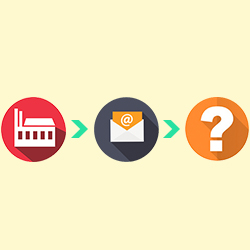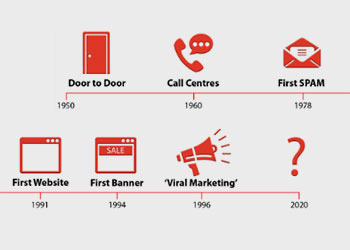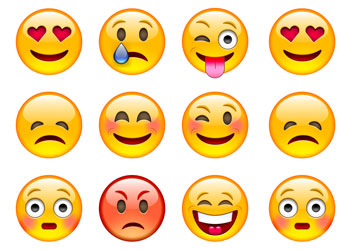What is the future of lead generation?
The Lead generation has been facing a permanent transformation and optimization towards a better sales process for the advertisers:

In the early 50s, the only popular lead generation strategy was the Door-to-door sales, pushing products like vacuums and cleaners to stay-at-home moms; then in the 60s the first call centres were used for the first time by Private Automated Business Exchanges (PABE); later, in 1978, the first unsolicited commercial email message (later known as spam) was sent out to 600 California Arpanet users by Gary Thuerk. In 1991, the first web page was created with the purpose of explaining what the World Wide Web was, and only 3 years later, in 1994, the first web banner ad was posted on HotWired.com for AT&T to drive traffic to their website. In 1996 the term ‘viral marketing’ was popularized in the magazine Fast Company with an article called ‘The Virus of Marketing’. Since then, online sales became natural and Social Media have become not only a way to communicate but also to express ourselves. Lead generation has moved from a hard sales perspective to an engaging and educational process to convert leads into sales in a short-mid time period.
But what is the future of Lead Generation? Will we be sending emails to generate leads in 5-10 years? What will happen with coregistration? And what is the role of Social Media lead generation in the future?
To talk about that we need to first understand lead generation not as a goal but as a process of an overall sales strategy. Lead generation provides with the tools necessary to proceed with a sale. The way to generate those leads has been always connected to the types of consumers, not as a target market but as a type of behaviour (What kind of channels do they use, what kind of language do they use, etc.). With this little definition we are able now to go through different points that we think will change in the next few years in the lead generation industry:
Sales Timeframe
If we compare an email campaign from 2010 and one from 2015, we will be able to see a radical change: We’ve gone from the online hard sale to the online suggestion. Lead generation has evolved from just a quick sale tool to a short-mid time conversion tool, and this evolution seems that will stay here. But why that? Any business would like to have a positive ROI with their investments in a very short time period, but considering how difficult is in any competitive market to get a sale, we want not only to secure a sale but also to secure a consumer. Any sale has three stages, the pre-sale, the sale and the post-sale. The sale and post-sale are focused on the product but the pre-sale (where lead generation happens) is all about the consumer and his needs. A lead generation campaign focused on sales only produces short-term sales but a low engagement with the consumer. Lead Generation is evolving to a more engaged consumer, focused on educating those leads towards a long-term relationship with the brand.

Personalization of the message – Number of emails sent
One of the big steps with the Bulk Emails was the introduction of automated personalized messages, in that way a brand like Coca-Cola could say “Hello Sarah” instead of the old fashioned and neutral “Dear”. Then we discovered that it was not only in the introduction but also in the message, adding more fields like [COMPANY], [DOB], etc…
We still have a long way to do in terms of personalisation. Internet gives us enough data of everyone to be able to give an answer to anyone’s needs. In this area we touch sensitive topics like privacy, but in the same way that we are able to send display messages or social media ads to people segmented by life events like “recently engaged” or “future parents” without knowing their identity, the future of email or coregistration campaigns will be to send several messages, personalized by much more than demographic or geographic variables.
In that sense, the number of impressions sent by advertiser will decrease but the conversion rate will certainly increase. That will give to the advertisers more qualified leads, and therefore a higher conversion rate from lead to sale.

Engagement and dialogue
Lead generation has changed thanks to Social Media creating a more engaging way to generate those leads, giving the chance to the user to ask questions and share or giving him the chance to choose if he wants to receive your messages or not. Email and coregistration are going in the same way: Emails will be more social and coregistration will be more interactive.
That will increase the conversion rate but specially the quality of the leads.

Mobile
This point would need a whole book to be analysed. Mobile has changed already our lives, and it keeps changing it. Almost everything in our lives has needed to adapt to mobile to keep alive. Lead generation is not an exception. 5 years ago, Mobile-friendly was a word that we used to describe a luxury, at the moment mobile responsiveness is a must, in five years-time, mobile integration will be something necessary.
When I say mobile integration I’m talking about emails sent by geo-location for example. The opportunities in this sector are endless.

In summary, we are moving from the big numbers of the Industrial Era to the quality and personalisation of the Modern Era. Lead generation is evolving from a perception of spam to a solution facilitator, from a broad tool to a very precise one.

Related posts
What does a 2015 e-commerce strategy look like for brands? Well according the Melbourne Online Retailer and ecommerce conference held last week, ecommerce strategies involve smart marketing, should be all encompassing, and including a plethora of solutions and services. All of this combined helps to ensure that brands are competitive in this modern day ecommerce […]
Understanding emotions that affect purchasing behaviours is a key to ensuring brands succeed with their marketing budgets. Lets look at an example. Kmarts ‘Bom Bom Bom’ campaign and the discount ‘everyday low price’ strategy. Kmart worked to change consumer’s attitudes to the brand using the ‘Bom Bom Bom’ and on the emotions that drive consumption […]
After more than 6 years of experience, I get the same question again and again: How can we engage our email lists from the initial subscription and convert them all the way through to loyal customers? For that reason, we joined last week a a Webinar with Bob Kamal from Lyris HQ who presented on […]










